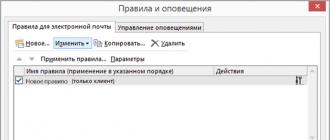50007 0
The urgency of the problem of introducing information systems into health care is determined, first of all, by the need to increase the efficiency of health management processes, the quality of medical care provided to the population. Until the mid-70s of the last century, the development of informatization lagged behind the growing needs of the health care system in the use of information technologies, after which the intensification and acceleration of work on the creation of computer systems for medical purposes began to appear.
Hospital departments and small administrative divisions were able to purchase computer equipment to create local information systems, however, attempts to create medical automated systems in our country relied on computers that did not provide for mass use, and therefore did not envisage further replication.
Large groups of people and entire computing centers were involved in the maintenance and support of the functioning of these systems. The situation changed when the first personal computers were created, which significantly expanded the basis for the computerization of health care and served as an impetus for the development of new generation software tools that made it possible to work with computers for people without programming skills.
In our country, the computer boom came at the end of the 1980s, when it was considered mandatory to have at least one personal computer in every institution. The development of domestic computer systems went in several directions, using, as a rule, the forces and means of a medical institution (Fig. 21.2).
At the same time, various requirements for software by personnel of many medical specialties, the presence of a large number of ready-made programs supplied with equipment and implemented on various platforms, the use of various information processing algorithms in different institutions in conditions of severe shortage of material resources extremely complicate the task of developing an integral information system. One of the main obstacles to the development of any health information system is the lack of uniform standards approved by law.
Nevertheless, the use of computer technologies makes it possible to save a specialist from routine paperwork by using the capabilities of a computer to process information for formalized data entry, automated reporting, etc. This is important if we consider that the doctor of the polyclinic is given 10 to 15 minutes to see one patient, and about 50% of this time is spent on completing the medical history.
Reduction of paper workflow occurs due to the use of computers when entering, storing, searching, processing, and analyzing patient data.
The modern concept of medical information systems involves combining existing information resources into the following main groups:
... electronic patient records;
... results of laboratory diagnostic tests;
... financial and economic information;
... drug databases;
... material resource databases;
... labor resource databases;
... expert systems;
... standards of diagnostics and treatment of patients, etc.
Medical information systems (MIS) serve as the basis for the phased creation of health and health monitoring at the federal and regional levels. By design, these systems are divided into three groups: systems, the main function of which is the accumulation of data and information; diagnostic and consulting systems; systems that ensure the process of medical care.
It is quite difficult to categorize unambiguously information systems used in health care due to the ongoing evolution of their structures and functions. The multilevel structure of health care management (municipal, regional, federal levels of government) can become the basis for the classification of medical information systems.
Information systems in healthcare within each level of management, depending on the specifics of the tasks being solved, are classified according to the following functional characteristics:
... administrative medical systems;
... search information systems;
... systems for laboratory and diagnostic studies;
... expert systems;
... hospital medical information systems;
... AWPs (automated, workstations of specialists);
... telemedia systems, etc.
Administrative medical systems provide information support for the functioning of a medical institution, including the automation of administrative functions of personnel. MIS of this level provide management of hospital, outpatient and polyclinic and specialized services at the administrative-territorial level. In functional terms, the system can be divided into five basic components: planning and forecasting activities; accounting and control over the activities of institutions and the formation of reports; operational management of individual services and auxiliary tasks (creation and maintenance of classifiers, standards, etc.).
This also includes information systems for solving specialized medical problems, providing information support for the activities of workers of specialized medical services, in particular information systems for certain areas: mutual settlements in the CHI system; management of emergency medical care to eliminate the consequences of emergencies; drug provision; personalized registers.
Personalized registers of the territorial level contain information on the assigned contingent of a municipal formation, a subject of the Russian Federation. Registers replace numerous paper forms of documentation (journals for registering patients for individual diseases, for age and sex, for dispensary observation) and facilitate the transition to paperless technology. The register ensures the solution of the following tasks: storage of a police card index for obtaining data at the request of specialists; formation of state reporting. In addition, the register makes it possible to more objectively assess the effectiveness of preventive, therapeutic, diagnostic and rehabilitation measures. Personalized registers, in fact, serve as “building blocks” of the territorial health and healthcare monitoring system.
An obligatory requirement is the availability of a system for protecting the confidentiality of personalized data during their transmission over telecommunication networks.
Ultimately, we are talking about the creation of a corporate information system that directly unites the information resources of hospitals and healthcare authorities using telecommunication networks. The implementation of this task will require large financial resources (comparable to the annual budget of the entire health care system in a separate territory), as well as training management personnel capable of using modern computer technologies.
In this regard, the initiative in the field of the introduction of computer technologies and the automation of resource management processes in healthcare should come from the healthcare authorities and the TFOMS, which in a number of constituent entities of the Russian Federation are quite effectively carrying out this work. Such territories include Novgorod, Murmansk, Rostov regions, Moscow, St. Petersburg, etc.
At the federal level, the creation of administrative medical systems allows solving problems that provide a strategic level of management:
... monitoring the implementation of the program of state guarantees for the provision of free medical care to citizens of the Russian Federation;
... monitoring the implementation of the national project "Health" and monitoring the effectiveness of the work of public authorities (GAS "Management");
... social and hygienic monitoring;
... monitoring the health of the population of Russia (analysis of the dynamics of the health status of the population in connection with socio-economic and environmental factors);
... maintaining state registers (register of privileged categories of citizens of the Pension Fund of the Russian Federation, etc.);
... management of medical educational institutions, movement and retraining of medical personnel;
... accounting and analysis of material and technical, financial resources of health care, etc.
Search information systems solve the problems of information support of medical personnel: preparation of abstract information for employees; webserver development and support and internet search; creation and maintenance of professionally oriented databases, registers of medicines, registers of medical services, etc.
Systems of this class do not process information, but provide quick access to the necessary data. Typically, search engines are subdivided by the types of stored information (clinical, scientific, regulatory, legal, etc.), by its nature (primary, secondary, operational, review and analytical, expert, prognostic, etc.), by functional characteristics (activity Medical facilities, material and technical base, medicines, etc.). There are documentographic, factual and full-text search engines.
The growth in the number of factual and documentographic search systems is explained by the fact that in the managerial activities of the head of a healthcare institution, in the clinical work of a doctor, in scientific and medical research, online access to factual data is more important than access to bibliographic data. The latter contain information about documents requiring additional study, while factual ones provide ready-made information search results. There are now a large number of commercial search engines. Of particular importance is the integration of medical search systems into a single information network, the Internet, which provides any doctor-user with access to information and the exchange of this information.
Systems for laboratory and diagnostic studies are designed for automated diagnosis of pathological conditions (including prognosis and development of recommendations for treatment methods), for individual nosological forms and groups of patients. Moreover, there are several classes of such computer systems: laboratory analyzers; digital X-ray diagnostic systems; CT scan; ultrasound diagnostics; visualization and comparative analysis of the results of histological studies, etc. Historically, this type of systems began to develop one of the first among medical information systems.
The most important areas of application of laboratory diagnostic systems are urgent and life-threatening conditions with insufficient clinical symptoms, limited examination capabilities, and a high degree of threat to life. Such systems can be used as part of telemedicine systems in multidisciplinary hospitals for remote consultative assistance to patients in primary care facilities (outpatient clinics, general medical (family) practice centers, CRHs).
Expert systems are effectively used in solving diagnostic problems, interpreting data, predicting the course of the disease and complications. One example of an expert system is the AKDO software and hardware complex, developed under the guidance of Professor V.V. Shapovalov, which is used for medical examinations of the population.
As information systems are introduced in healthcare institutions, expert systems can be used at a higher quality level - as systems for data mining, searching for patterns and developing alternative solutions in the management of medical institutions.
The main components of such systems are: database (knowledge), modeling algorithm, user interfaces and interfaces with factual databases.
The training system contains a database containing methodological and reference information that allows you to evaluate and deepen the student's knowledge, test tasks and multimedia applications for visual teaching.
Standard programs represent various complexes of training exercises and practical methods, more complex ones are designed to help students master the skills of solving problems such as making a diagnosis, developing a treatment plan, and predicting long-term consequences. Modern medical expert systems are integrated with other types of information systems.
Hospital medical information systems combine the functionality of several types of automated systems on the basis of electronic medical history (EIB) and comprehensively solve the problems of managing a healthcare institution. The development and adoption of integrated solutions based on the EIB analysis allow you to manage the processes of improving the quality of medical care for patients. EIB serves as an electronic analogue of the patient's summary medical history, which should be kept throughout his life and accumulate all information related to his health.
EIB allows a doctor in real time to access structured information about a patient of any age, stored in the archive, and use it for further examination, treatment and observation of the patient.
The functioning of the EIB is provided by the DBMS, the Database for the EIB consists of two main components: a module for reference documentation and a data storage module. Regulatory and reference documentation includes territorial and intra-institutional reference information (reference books and classifiers).
The data storage module is an EIB bank for treated (archived) and undergoing treatment (surgical) patients. The database provides storage of all information on each patient under a unique identification number. The widespread implementation of such systems is hampered by the insufficient development of corporate information networks of medical institutions, as well as the lack of the necessary regulatory framework.
When informatizing both medical institutions and health authorities, the following requirements should be adhered to. First of all, the use of computer technology should not increase the volume of work of medical personnel and significantly change the style of their work. Secondly, those structural units, where the information is recorded for the first time, should be automated initially.
Management tasks require a manager of any level to use and process a large amount of information, analyze it in various planes, simulate processes and situations, and structure material for making management decisions. For the prompt and high-quality performance of these tasks, an important role is played by an automated workstation for managers, for the development of which modern information technologies are used, such as online analysis of distributed databases and public network technologies, statistical packages and decision support systems, geoinformation systems.
The workstation of a clinician (therapist, surgeon, obstetrician-gynecologist, traumatologist, ophthalmologist, etc.) is subject to requirements corresponding to the specifics of their medical functions.
The AWS may include expert systems, mathematical models that provide an analysis of various situations and provide a specialist with additional information for making clinical decisions.
The most important direction of using information systems in health care is telemedicine.
The origins of telemedicine are attributed to the organization of medical supervision of astronauts during space flights. With the advent of network technologies, modern methods of information transfer, which made it possible to provide a multilateral exchange of video and audio information, telemedicine received a new powerful impetus in its development.
The main condition for the formation of telemedicine was the development of a multi-level medical infrastructure, for the interaction of individual elements of which the introduction of these technologies was most in demand (Fig. 21.3).

Figure: 21.3. Scheme of the organization of telemedicine consultations
This made it possible to carry out the necessary medical and diagnostic consultations from federal and foreign medical centers, regional medical institutions for patients undergoing treatment at the Central District Hospital, centers of general medical (family) practice.
The economic efficiency from the introduction of telemedicine into practical health care can be assessed according to such Criteria as a reduction in treatment costs due to a decrease in the number of erroneous diagnoses and inadequately selected treatment regimens, and a reduction in unproductive time spent by medical personnel on training while away from their jobs.
One of the areas of using telemedicine technologies is the introduction of distance forms of medical education, which make it possible to raise the quality, first of all, of the postgraduate system of training healthcare workers.
Without qualified personnel with practical skills in working with computer technologies, it is impossible to ensure the effective functioning of the entire health care system.
O.P. Shchepin, V.A. Medic
Humanity, in the course of its existence, comes up with various possibilities to facilitate its existence and simplify life. One such tool that frees you from routine is the Medical Information System (MIS), which helps coordinate the health system.
Information system
What is generally understood by them? An information system is defined as an information processing system that works in conjunction with people and the financial resources on which the provision and distribution of information depends.
Automated system
An automated system is called a complex that consists of human labor automation and personnel who serve it. The speaker performs functions pre-programmed for it. In the case of the presence of several automated systems (from two pieces), provided that the functioning of one directly depends on the other (others), then they are called integrated.
Medical information systems

Luminaries of science give different definitions of MIS. But the most popular option sounds like this: a set of software, information, technical and organizational tools that aim to automate medical processes / organizations. But for completeness, you should read one more. It sounds like this: MIS is a form of organization of medical processes that enable medical personnel, with the necessary technical support, to use a set of tools that ensure the collection, processing, analysis, storage and output of information for medical purposes, which relates to health and its condition for specific person. In addition to conventional MIS, diagnostic and related ISs are additionally distinguished. It was not possible to designate them into clearly defined groups due to the fact that there is no clear state standard that would be processed with high quality, therefore there is no generally accepted division into various medical information systems. The classification is, however, carried out by individual specialists or groups of specialists.
Classification of medical information systems

Due to the novelty of the technology, there are no state approved standards yet, so I bring to your attention the following classification:
- Information services. Information service for patients. It aims to provide the widest coverage of work and service for the maximum number of people in the shortest time intervals.
- Information technology medical systems. The object of work is a patient, the user is a medical worker.
- Information and statistical medical systems. Creates the population of the served region. The division is carried out according to objects and on a territorial basis.
- Research medical information systems. The main subjects of work are documents and objects of science. They are additionally divided into subsystems depending on the differences in the description objects.
- Information-training and educational medical systems. Trainers provide support to those who go through the training and learning process. Educational systems are used to assess the level of knowledge.
But besides this, MIS are also divided into subsystems and have a number of additions. So, medical information systems, the classification and purpose of which is difficult, were brought into diagnostic and related types. Additionally, a determination is made as to whether the system is complex or not.
Complex systems
A medical information system (MIS), which deals with both administrative and clinical functions, and for which an electronic medical record is chosen as the core, is called an integrated automated medical information system. It includes:
- Taking care of the automation of accounting, personnel and economic services, office work, engineering support, material and technical supply - everything that allows you to automate administrative and economic activities.
- System of personal accounting of medical care. Maintaining support subsystems of procedural and diagnostic departments with a hospital pharmacy.
- Reference information. This can be as a complex description of various problems, methods of their treatment, symptoms, and the schedule of doctors, laboratories, their level of employment and a short dossier.
Diagnostic medical information systems

The task of this type is to receive, transfer and analyze data that was obtained as a result of certain diagnostic or laboratory studies, using special external devices. Due to the frequency of cases when DIMS or MIS is installed and the differences in their functionality, they are considered as separate systems. But if there are medical information systems, then DIMS is considered its subsystem. Its purpose is to supplement the main one.
Related medical information systems

Modules for special use (usually medical or household). SIMS can include personnel or accounting systems, full-fledged pharmacy systems (which can provide planning, procurement, and distribution of medicines and medical inventory), systems for automating processes in specific departments. Despite the introduction of this topic in the article, in practice it is considered exclusively as an addition, the purpose of which is to increase the functionality.
Modern systems and their use

And finally, about some of the medical information systems in Russia, which are used (though not very common) in medical institutions.
Medical information system built on a modular basis. It is designed to automate the processes of activities of hospitals and clinics. The number of modules for them is 11 for each institution. Allows for data exchange and centralized collection of necessary indicators. Supports interaction between staff, collects data to inform the management of the institution in which BARS is installed. The medical information system makes it possible to ensure work not only with the staff, but also with patients and facilitate their interaction with the medical institution in matters of making an appointment, writing prescriptions, sick leaves, and calling for emergency help. Based on the data received, it can generate reports on the status of individual patients, doctors and medical institutions.
It is an integrated information and functional environment that has united various classes of medical information systems (MIS). Support for hospital services, from financial reports and documentation to individual patient records. Integration with and support of decision making systems is important.
An information system of a medical institution that automates activities, planning and optimizes patient treatment processes. It allows you to reduce the time spent on documentation, coordinates the work of doctor's offices and laboratories, optimizes the use of labor resources, and organizes the prompt exchange of information.
MIS-Ristar is a set of programs, web applications and services working with a single database.
MIS-Ristar is supplied either as part of a hardware and software complex, or pre-installed on workplaces provided by the customer, or in the form of a distribution kit and provides automation of input, processing, storage, search and analysis of ALL information processed by the administration and personnel of medical institutions.
MIS-Ristar includes:
Database is a storage of accumulated information and procedures for processing this information.
- Applications designed to automate the workplaces of the administration of medical and prophylactic institutions, doctors, middle and junior medical personnel, as well as non-medical personnel.
- A set of Internet applications and services for patients, staff and administration of medical institutions, as well as for business owners (for private medical institutions)
- The module for analyzing accumulated data and generating reports, which allows you to form arbitrary queries to the Database, receive any reports and analytical information, analyze the accumulated data according to freely formed search criteria
- Special software "tools" that allow you to quickly configure the system as a whole and each workplace, depending on the specifics of the work, including:
- "designer" of programs (courses) of treatment / examination / rehabilitation, designed for the appointment of diagnostic studies, sets of treatment and recovery procedures, in-depth medical examinations and medical commissions "with one button"
- "constructor" of structured documents ("templates") of an electronic medical record (hereinafter EHR), which allows you to customize screen and printed forms of EHR documents, as well as to link the fields filled in the document with the database. At the same time, you can work with each EHR document both as a text document and as a structure optimized for automatic processing
- "editor" of "complex norms", to quickly set up the conditions for checking the reliability of the received data, for example, from diagnostic equipment and automatic assessment of "deviations from the norm" depending on the values \u200b\u200bof other parameters (height, weight, age of the patient, type of equipment, individual characteristics of the patient etc.)
- "designer" of printed and screen forms and forms, which allows you to create new or modify previously created reports and queries to the database (DB) required to select from the database information displayed in these forms
- "subsystem for setting print parameters", which provides setting the order of printing all documents by all users (the number of copies by default, preview, etc.) at the level of the system as a whole, for a specific organization, department or user
- "constructor" of data structures and registered parameters, which provides unlimited expansion of the list of data stored and processed by the system, including for use in analytics and reports (in fact, it allows you to add new "fields" to the database without making changes to the program code and structure DB)
Individual settings for each user (types of screens, sizes and colors of fonts, etc.)
- Special software "tools" and "constructors" to support the export / import of data for organizing information interaction with third-party information systems (laboratory information systems (LIS, image storage and processing systems (PACS), administrative automation systems, third-party medical information systems) , information systems of the regional and national / federal levels, etc.)
Configuration and architecture.
In general, MIS-Ristar can be configured to operate:
- at separate workstations (automated workstations)
- within the local area network of the department (division)
- within the institution as a whole
- in a single information space that unites various medical institutions, including those remote from each other, connected by local information networks or Internet channels.
The software runs under MS Windows 2000, Windows XP, Windows Vista, Windows 7 and older
Oracle DBMS Oracle 10g, 11g and older (for small solutions - up to 20 workplaces, the DBMS is included in the supplied solution and does not require additional costs for licenses
Architecture - Client-Server, or multi-tier architecture.
Special technical solutions allow the implementation of the system in various versions, depending on the requirements and capabilities of the customer:
- Option I. Integrated supply of equipment and software, installation of workstations at each workplace.
- Option II. Launching the system and starting work in the minimum version with subsequent expansion (you can start with 2-3 workstations). Expansion work boils down to connecting new workplaces, customizing them depending on specialization, connecting additional functional blocks of software.
Option II is recommended when implementing MIS-Ristar in an already operating institution, because it is impossible to distract all personnel from the main work at the same time to conduct training, as well as during the installation and setup of workplaces.
Expansion and development by "regular" means of MIS
MIS-Ristar can develop in several directions:
-
connection of additional workplaces-
connection of additional functional modules-
combining several institutions and organizing their work with a common Database, with the ability to obtain relevant reporting and analysis of the stored information, both separately for each institution or group of institutions, and throughout the entire Database-
promptly making changes to reports already in use or generating and including new arbitrary reporting and analytical forms in the list of available reports-
promptly making changes to already used forms and printed forms or adding new free printed forms and forms-
unlimited expansion of the range of stored data, including the addition of new "fields" without changing the structure of the Database and without the involvement of programming specialists-
by additional agreement, the development and connection of new functionality and / or new applications.Internet applications and services:
1) Self-recording. It is used for direct self-registration of patients with a doctor using the link on the website.
2) Information kiosks (infomats) installed in the lobby of the medical facility. Used for self-enrollment of patients with a loaded registry or for appointment with specific specialists / for specific examinations (procedures)
3) Subsystem of notifications and E-mail mailings
4) Remote registry. Web-interface to workstations in the registration and patient appointment. It can be used for remote registration, for example, during preventive or prophylactic examinations directly at the exit on the territory of the institution that ordered the examinations. Doctors for recording "from home" upon the patient's call. Registry work from remote branches. Information department (Call-center) for enrolling patients along with the “fat” client.
5) Remote workplaces of doctors. Web-interface to the workstations of the medical staff for maintaining electronic medical records (EHR) of patients. It can be used for organizing remote workstations when leaving "home", when working with remote branches with weak or unreliable Internet connection.
6) On-line Questionnaires. Allows the patient waiting for an appointment to fill out the appropriate questionnaire - frequently asked by the doctor questions from the informant or by self-recording via the Internet. The completed questionnaire is included in the patient's "medical history" and allows the doctor not to waste time on preliminary questioning of the patient. Questionnaires can be made for each medical specialty, in fact, this is a preliminary collection of complaints and anamnesis - everything that the doctor writes down in the "medical history" "according to the patient's words." Additionally, it is equipped with a module for setting up and processing "scanned" questionnaires (when filling out questionnaires "on paper", for example, during medical examination.
7) Information table. Allows you to display on the TV screen and / or external monitor the current reception schedule with the indication of free / occupied seats.
8) Links to the schedule grid for an external site.Designed for direct links from sites.
9) Published price list. To display the price list on an external site.
10) Published schedule.
11) Print service (converting protocols filled in by doctors into Word and / or PDF) - directly from the DocMainFrom.exe task.
File sharing
1. "Attaching" files to the patient's "medical history" - files are saved in a separate file storage
2. Two-way data exchange with LIS (PACS). VLIS (PACS) napplications for conducting research in files of appropriate formats are sent, research results are returned from the LIS in files of agreed formats and PDF forms for printing and distribution to patients.
3. The same scheme is used to exchange data with functional diagnostics devices, special simulators, third-party systems, etc.
Integration with third-party information systems
1. Setting up information interaction in accounting automation systems (1C, Parus)
2. Bi-directional data exchange with imaging and radiological systems (PACS, RIS)
3. Two-way information exchange with laboratory automation systems (LIS)
4. Integration with a pharmacy warehouse management system (pharmacy kiosk)
5. Integration with federal and regional services of the Unified State Health Information System (setting depending on the region)
6. Integration with any third-party information system according to the customer's specifications






